LAMB CUTTING
Method
This procedure as described may also be followed for the processing of deer, goats, sheep or other animal carcasses of similar size.
Cooling
All lamb carcasses should be promptly chilled and kept at a low temperature (-2° to 2°C) until cut and utilized. Do not permit lamb carcasses to freeze within a day after slaughter or the meat may toughen. Lamb carcasses can be cut into retail cuts after they have been chilled for 24 to 48 hours.
Carcass
Lamb carcasses are generally not split into halves after dressing because they are not thick enough in any location to create cooling problems. Begin cutting the lamb carcass by removing the thin cuts, i.e. flank, breast and foreleg. Lay the carcass on the cutting table and mark one side from the cod or udder fat in front of the hind leg to the elbow joint (Figs 107, 108 and 109). After removing the thin cuts from both sides, remove the kidneys, kidney fat and diaphragm (Fig. 110). Next the carcass is turned over and the neck removed either in thin slices to be braised or in one piece to be added to stew or to be boned and ground.
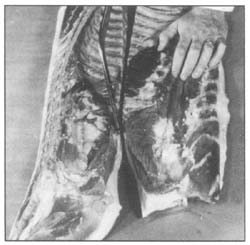 |
106. Separating spare-ribs from the belly |
| 103. Dividing the centre section of the pork side into loin and belly | 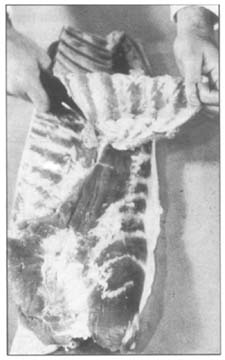 |
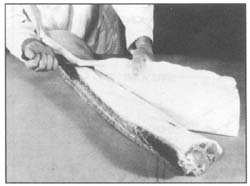 |
|
| 104. Removing the fat cover of the loin | |
| 105. Smaller roasts and chops from the loin | 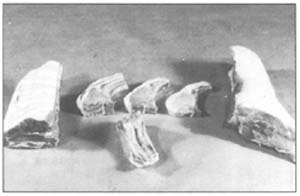 |
The trimmed carcass can then be separated into four primal cuts, each with different characteristics. A cut between the fifth and sixth rib removes the shoulder. Another cut between the twelfth and thirteenth (last) rib separates the rib from the loin. The loin and legs are separated just in front of the hip bones by cutting through the back where the curve of the leg muscles blends into the loin (Fig. 111).
107. The lamb carcass and its bones
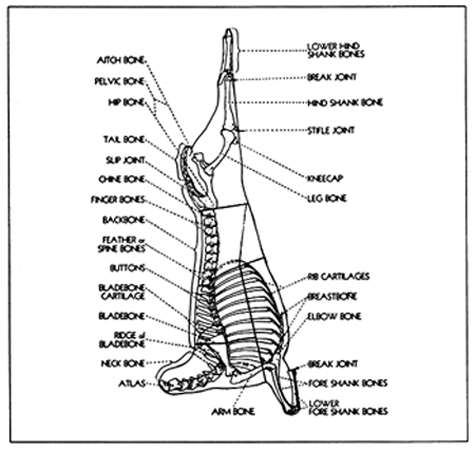
108. The lamb carcass and its cuts

Rib. The rib of lamb is prepared by sawing through the ribs on both sides of the backbone (Fig. 116). The main portion of the backbone is then removed with a knife. Rib chops are easily made by cutting between the ribs. Remove the fell before cooking the chops. The breast portion may be barbecued in one piece or made into riblets by cutting between the ribs (Fig. 117).
Shoulder. After splitting through the backbone, the shoulder may be roasted as is, made into chops, or boned and rolled into a roast. Arm chops should be made first by cutting parallel to the surface where the foreleg and breast were removed. Blade chops are made by cutting between ribs and sawing through the blade- and backbones. To prepare a boneless shoulder, first remove the ribs and backbone by cutting closely underneath the ribs, backbone and neck vertebrae. Next from the rear surface cut along the inside of the blade-bone to expose it and the armbone. Cut along the edges of the bones and remove them (Fig. 118). Roll the meat and tie it securely with clean twine. The boneless shoulder may also be made into a pocket roast and stuffed with ground lamb or other dressing. The edges of the pocket roast are stitched together.
| 109. Removing the thin flank cuts | 110. Kidneys, kidney fat and diaphragm removed from carcass |
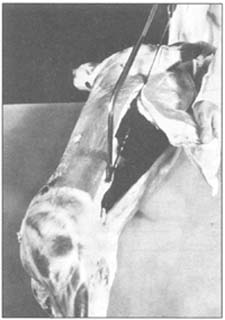 |
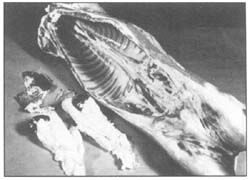 |
Shanks. Both the fore- and hind shanks when removed can be barbecued, cut into pieces for stew or boned and the meat ground.
| 111. Lamb carcass separated into four primal cuts (shoulder, rib, loin, legs) | 113. Separating the shank from the leg |
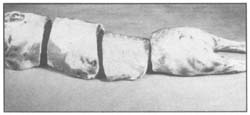 |
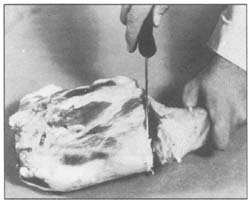 |
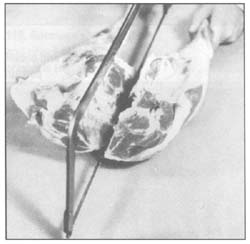 |
|
| 112. Splitting the legs |
Lean trimmings. Lean trimmings of lamb in chunks are suitable for stews or to be marinated and used for special roasts. Other lean trimmings can be ground and used as one would prepare ground veal or beef.


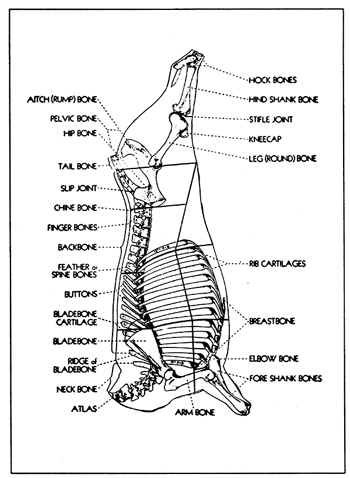
This is really nice to know. I hope it will be successful in the future. Good job on this and keep up the good work.
I am sure this post has touched all the internet people, its really really nice paragraph on building up new webpage.|
I’m really impressed with your writing skills as well as with the layout on your blog. Is this a paid theme or did you customize it yourself? Either way keep up the nice quality writing, it is rare to see a nice blog like this one nowadays..
Hi, I do think this is an excellent blog. I stumbledupon it 😉 I will come back once again since i have book-marked it. Money and freedom is the greatest way to change, may you be rich and continue to help other people.
By the Way, If you are looking to improve your web site with additional useful, interesting, internet search engine friendly content to create huge traffic and more profit, than I highly recommend you to visit this web site to along with the most vauable Article Marketing Tools. All the best – Ivelisse